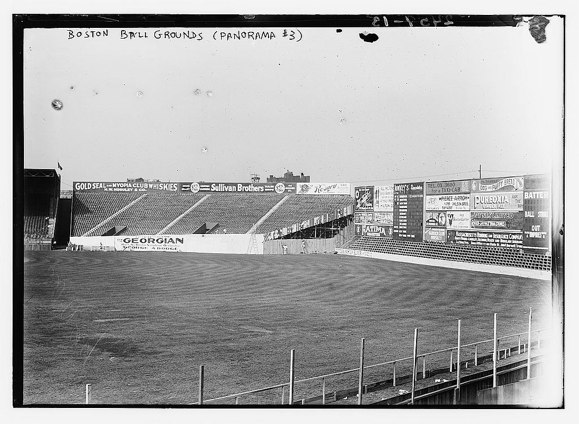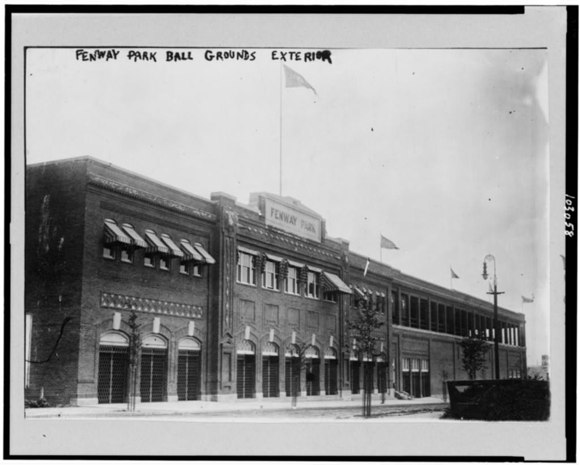
Today’s Red Sox/Yankees game marks the 100th anniversary of Fenway Park — the first Major League Baseball facility to reach the century mark and an enduring part of the American Experience.
Nostalgia is a powerful force in our society these days; everything, it seems, is an echo of the past in some manner. Whether it be retro ballparks, clothing revivals (yeah, we can’t understand ’80s styles coming back, either) or 1950s Modernist furniture updated and streamlined at Ikea, the world of today looks suspiciously like the world of yesterday.
At its best, nostalgia is a retreat to a better and simpler time. At its worst, nostalgia is a misplaced desire for a world that never existed. We all think our lives were simpler when we were children, and they were — because we didn’t bear the responsibilities of our parents and grandparents. If your father is like ours, he’s not too damn eager to return to the 1960s, with a lower quality of medical care and in general a much harder life experience.
And we see a little of that misplaced nostalgia at play in remembrances of Fenway Park. In a disposable society, Fenway Park is revered as being part of an unchanging ballpark experience; squint a little, say those yearning for the past, and you can imagine Smoky Joe Wood on the Fenway mound instead of Clay Buchholz. Besides Tiger Stadium (which opened 100 years ago today as well), which was 97 years old when it was torn down in 2009, and Wrigley Field — 98 years old this year — no other MLB ballpark has made the 100-year mark: Comiskey Park was 81 years old when the White Sox moved to the new Comiskey. Even a relatively young MLB franchise like the Washington Nationals have called four ballparks home since the team’s beginnings in Montreal.
Change is inevitable and needs to both recognized and celebrated when done correctly. The Fenway Park of today isn’t close to being the same as the Fenway Park of 1912. Sure, we’d like to think it is, and many enthusiasts waxing nostalgic for their youth insist that nothing at the ballpark has changed.
But it has.
Witness the photograph above, taken in 1912 as the Red Sox prepped for a World Series appearance. It’s the third panel of a three-panel panorama, and it shows the left-field corner and the predecessor to the Green Monster. Note the seating in front of the future Green Monster, which existed solely because the edge of the ballpark was at Lansdowne Street and it was a great place for hanging advertisements. No one with the Sox was trying to create an iconic experience; they were trying to make a buck. Over time the seating would be replaced by a 10-foot incline leading up to the Green Monster in lieu of a warning track. It became known as Duffy’s Cliff, and it wasn’t uncommon for ballparks to feature such an incline before warning tracks become popular: Thomasville’s Finch Field still features an incline dating back to the days when the ballpark hosted Minor League Baseball, and both Isotopes Park and Minute Maid Park feature center-field inclines reminiscent of those found at Fenway Park and Crosley Field.
But we digress. The point, which bears repeating, is that Fenway Park doesn’t stand after 100 years because it hasn’t changed. It stands because it has changed. When Ted Williams joined the Red Sox, the right-field seating was adjusted to make it a more inviting target for the Splendid Splinter, leading to the Williamsburg addition. When John Henry and crew took over the Sox and Fenway, they instituted a 10-year renovation plan that adapted the old place for modern times, whether it expanded concessions or a carnival experience at Yawkey Way.
So celebrate Fenway Park today for the right reasons: after 100 years, it’s still a great place to watch a ballgame because of changes made to it over the years — cramped seating, narrow concourse and all.
Considering the importance of the day, the Red Sox have scheduled a relatively subdued event. The gates are already open for the 3 p.m. ET game. Both clubs will wear replicas of the uniforms they wore for that inaugural game, played on April 20, 1912, though there was one difference: the Yankees weren’t yet the Yankees; they were the New York Highlanders, fresh off a move from Balitmore and a few years in front of the name change.

Images courtesy of Library of Congress, LC-DIG-ggbain-10961.
RELATED STORIES: Red Sox mark Fenway Park’s 100th anniversary with ballpark events
—-
Share your news with the baseball community. Send it to us ateditors@augustpublications.com.
Are you a subscriber to the weekly Ballpark Digest newsletter? You can sign up for a free subscription at the Newsletter Signup Page.
Join Ballpark Digest on Facebook and on Twitter!
Follow Ballpark Digest on Google + and add us to your circles!
